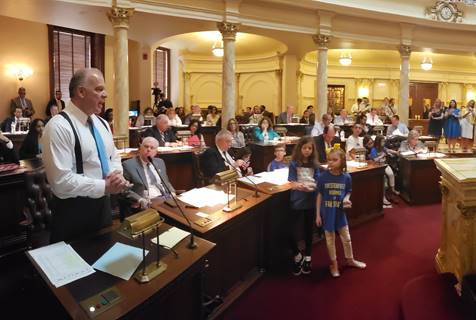
Landmark Reform Would Remove Growth Caps and Phase Out Adjustment Aid; Amendments Shield Schoolchildren in Overtaxed, Underfunded Districts from Cuts
TRENTON – The Senate today approved landmark legislation sponsored by Senate President Steve Sweeney to restore fairness to the state’s school aid formula by eliminating “growth caps” to provide proper funding to districts with growing enrollments and establishing a seven-year phase-out of the “adjustment aid” that continues to compensate districts for students they no longer have.
The Sweeney legislation, Senate Bill 2, is accompanied by language in the budget bill that will shift $60 million in aid from adjustment aid districts and increase state aid by $65 million more than the $283 million recommended in the Governor’s budget in order to bring the overwhelming majority of underfunded districts to 58% funding.
School districts in 17 of New Jersey’s 21 counties will receive a net increase in funding in the upcoming school year. The plan will provide increased school funding for school districts that educate 72% of the state’s schoolchildren.
“Our legislation will ensure that the School Funding Reform Act of 2008 lives up to its promise to provide fair and full funding for all children,” said Senator Sweeney (D-Gloucester). “State aid is supposed to be distributed based on each district’s property tax wealth, its ability to pay, enrollment changes, and the special needs of its schoolchildren. Lifting the growth cap and phasing out adjustment aid ensures that state aid ‘follows the child’ as the SFRA intended.
“But we have to make sure that state aid is not cut to districts that are spending less than the adequacy budget that the SFRA considers necessary to provide a ‘thorough and efficient’ education because their overall property taxes are so high,” he said. “And we need to ensure that students do not suffer in districts that are receiving more than their fair share of state aid, but are still underfunded because they are paying less than their fair share of property taxes.”
The budget bill includes a five percent reduction in adjustment aid for the upcoming 2018-2019 school year, and the Sweeney legislation calls for additional reductions of eight percent in 2019-2020, then by 10 percent, 14 percent, 18 percent, 21 percent and 24 percent through 2024-2025, when all “hold harmless” funding would be eliminated and these districts would be at 100 percent funding.
Senator Sweeney noted that the overwhelming majority of the districts facing a seven-year phase-out of Adjustment Aid are spending above “adequacy” – the level set in the 2008 School Funding Reform Act as necessary to provide the “thorough and efficient” education required by the New Jersey Constitution. The amendments added to the bill are designed to provide additional protections for students in over 40 urban, suburban and rural districts that are facing adjustment aid cuts even though most are spending below adequacy.
The first change would protect students in districts that are spending below adequacy, but where the total school, municipal and county property tax burden constitutes “municipal overburden.” The N.J. Supreme Court recognized the issue of municipal overburden in former Abbott districts, but upheld the SFRA law under the assumption that the State would provide “additional aid to those districts that are unable to raise their LFS [Local Fair Share] in future years.” The Sweeney bill gives the state Education Commissioner the power to eliminate adjustment aid cuts to former Abbott districts that are spending below adequacy, but taxing above 100 percent of the state equalized tax rate. This provision currently affects Pleasantville, Gloucester City, Millville and Vineland.
The amendment also gives the Education Commissioner the authority to limit cuts for former Abbott districts that are spending above adequacy, but meet the standard for municipal overburden, by limiting adjustment aid reductions only to the amount that they are spending over adequacy. This provision currently applies to East Orange and Keansburg.
A third provision would eliminate adjustment aid cuts in non-Abbott districts that are spending below 90 percent of adequacy and have a municipal property tax overburden at least 10 percent higher than the state average. Four districts currently qualify: Brooklawn, Fairfield Township and Lawrence Township (both Cumberland County), and South Amboy.
A fourth section directs districts facing adjustment aid cuts that are spending below adequacy because they are taxing below their Local Fair Share as established under the SFRA formula to raise their local school property taxes by a minimum of two percent a year to guarantee educational quality while adjustment aid is being phased out. This would currently affect 36 districts.
Finally, to ensure that districts receive the needed support, former Abbott districts that are facing adjustment aid cuts – some of which are taxing far below the state average – will be given cap waivers authorizing them to raise school property taxes to their full Local Fair Share.
The bill would not take any money away from Career Technical Schools. It would create a category of aid called “vocational expansion stabilization aid” to ensure vocational technical schools receive either the amount determined under the formula or the amount of aid received in the 2017-2018 school year, whichever is greater. This will address the unique needs of the vocational schools which cannot raise their own taxes to offset any reductions in state aid.

